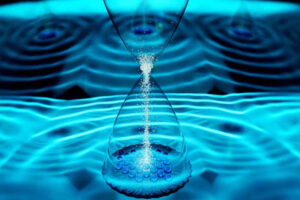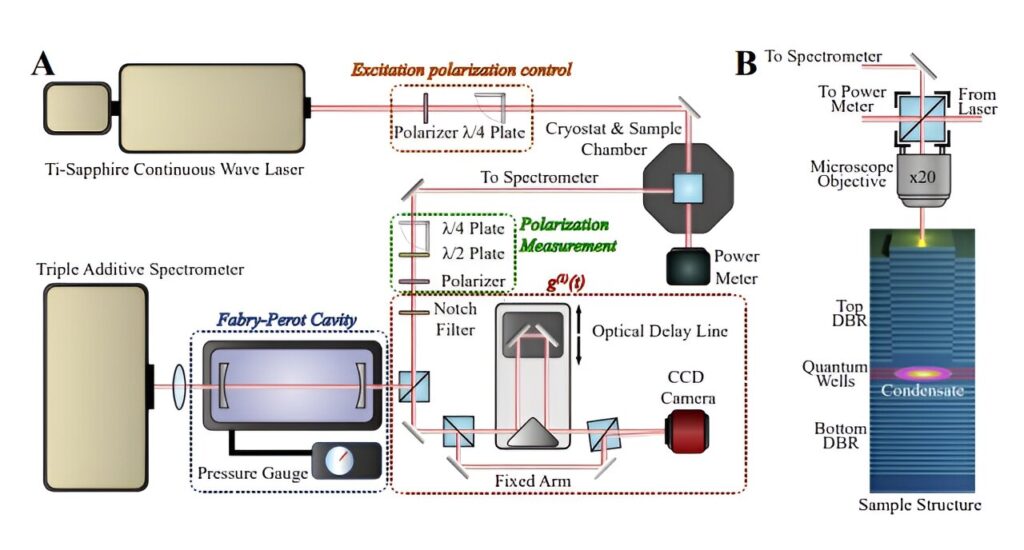For the first time, scientists have seen a time crystal oscillating at several billion times per second on a microscale semiconductor device, revealing extraordinarily high non-linear dynamics in the GHz region.
The experiment’s findings, which were published in Science, provide evidence of a strong link between hitherto unrelated fields of non-linear exciton-polariton dynamics and coherent optomechanics at GHz frequencies, according to scientists at the Centro Atómico Bariloche and Instituto Balseiro (CAB-IB) in Argentina and the Paul-Drude-Institute for Solid State Electronics (PDI) in Berlin, Germany.
A top-notch semiconductor-based sample that serves as a trap for coherent light-matter condensates was used in the investigation.
The sample was designed and built at PDI. It was made by stacking semiconductor materials in layers that were one atom thick under extremely high vacuum, which finally formed a micron-sized “box” that could trap millions of quantum particles. After that, it was moved to CAB-IB for examination.
The particles within the sample started to vibrate at GHz frequencies, or one billion times per second, when the CAB-IB team pointed a time-independent, or continuous, laser at it.
A top-notch semiconductor-based sample that serves as a trap for coherent light-matter condensates was used in the investigation.
The sample was designed and built at PDI. It was made by stacking semiconductor materials in layers that were one atom thick under extremely high vacuum, which finally formed a micron-sized “box” that could trap millions of quantum particles. After that, it was moved to CAB-IB for examination.
The particles within the sample started to vibrate at GHz frequencies, or one billion times per second, when the CAB-IB team pointed a time-independent, or continuous, laser at it.
“This behavior can be interpreted as different manifestations of a time crystal,” said Alexander Kuznetsov, a scientist at PDI.
“The demonstrated results add a new dimension to the physics of open many-body quantum systems, enabling frequencies several orders of magnitude higher than before and presenting new ways to control the emerging dynamics, which lead to the fascinating time crystals on a semiconductor platform.”
What are time crystals?
Researchers have been searching for elusive “time crystals”—many-body systems made of particles and quasiparticles like excitons, photons, and polaritons that, in their most stable quantum state, vary periodically in time—ever since Nobel Prize-winning physicist Frank Wilczek first proposed his theory more than ten years ago.
The core conundrum of Wilczek’s theory was whether the most stable state of a multi-particle quantum system could be periodic in time. In other words, is it capable of exhibiting temporal oscillations that are typified by a steady, rhythmic beating?
Time crystal behavior cannot exist in isolated systems, as was quickly demonstrated (systems which do not interchange energy with the surrounding environment). However, rather of putting an end to the discussion, this unsettling query spurred researchers to look for the circumstances in which an open system—that is, one that exchanges energy with its surroundings—might exhibit this kind of time crystal behavior.
Even though time crystals have now been seen multiple times in systems that have been driven out of equilibrium, there is still much that is unknown about them. For example, scientists do not yet fully understand their internal dynamics, and their potential applications have remained in theory rather than reality.
“This work presents a paradigmatic shift in the approach to time crystals, by offering a possibility to extend such studies to arbitrary-large arrays (lattices) of localized time crystals to study their interactions and synchronization,” said Alejandro Fainstein, the senior researcher and professor who led the CAB-IB team.
“Through it, we have been able to unveil peculiar behaviors of quantum materials. Because the materials involved are semiconductors compatible with integrated photonic devices, and the frequencies displayed are relevant for both classical and quantum information technologies, we envision additional stages in which we will try to control these behaviors for applications, including photon-to-radiofrequency conversion at the quantum level.”
Potential applications
The study team believes that time crystals might be useful in integrated and microwave photonics, based on the results of this experiment.
“The results have potential applications in (quantum) conversion between microwave and optical frequencies due to the polariton-enhanced coupling between GHz phonons and near-infrared photons,” stated Paulo Ventura Santos, a senior scientist at PDI.
Due to its potential applications in on-chip photonics, semiconductor-based non-linear optoelectronic systems—devices that may convert light energy to electrical energy or vice versa—are receiving special attention. However, because their electrical and optical characteristics are determined by many-body complexes (like time crystals), they are notoriously challenging to understand.
“A deeper understanding of well-defined regimes within these many-body systems, such as the ones the PDI/CAB-IB team helped to identify, can help elucidate these internal dynamics—and in turn help develop methods to control and harness such systems for applications,” said Gonzalo Usaj, the theory leader from the CAB-IB team.
The article was published in PHYS.org and further edited by the THE VOLT POST.




